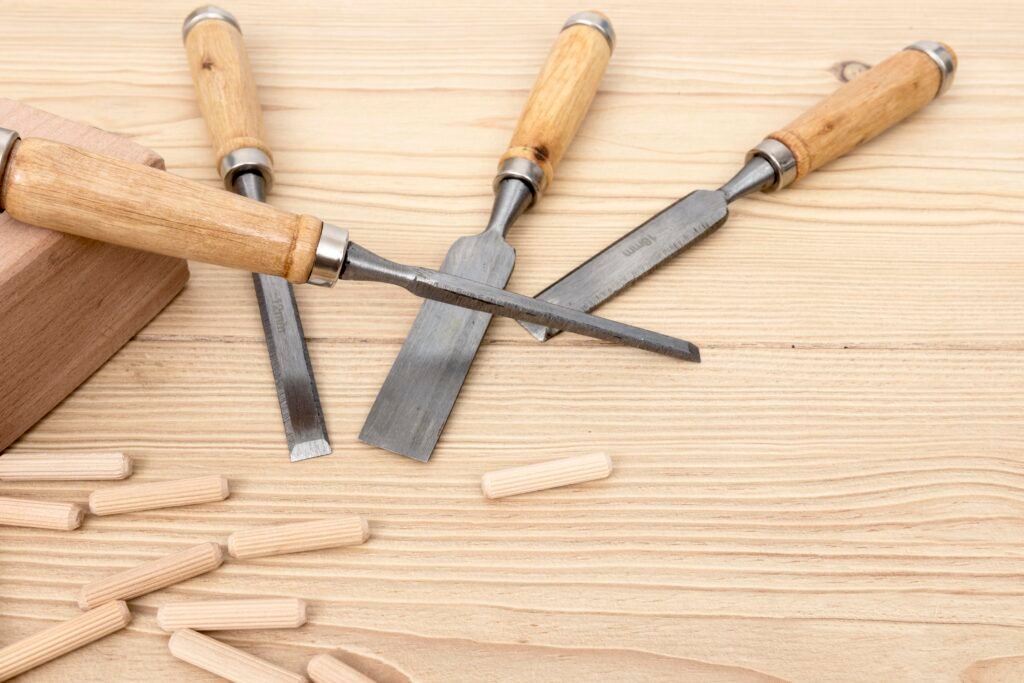
Woodworking is a timeless craft that requires a set of tools to make precise cuts, shapes, and finishes in wood. Common wood cutting tools like axes, saws, and chisels have been fundamental for tasks ranging from furniture making to larger construction projects. Whether you are a novice or an experienced woodworker, understanding the tools and their functions is crucial for ensuring successful results in your woodworking endeavors.
In this blog, we will explore the most Common wood cutting tools like axes, saws, and chisels, the tasks they excel at, and how to use them effectively to achieve the best outcomes in your projects.
1. Axes
An axe is one of the oldest tools used in woodworking and remains crucial for various wood cutting tasks. It’s known for its ability to chop, fell, and split wood, but its versatility extends to shaping and carving as well.
Common Uses of an Axe:
- Felling Trees: Axes are often used to cut down trees, particularly for smaller trunks. The sharp, heavy blade of the axe makes felling trees more manageable.
- Splitting Logs: After felling trees, an axe is effective in splitting logs into smaller pieces, which can then be used for firewood or other purposes.
- Shaping Wood: Specialized axes, such as hewing axes, are used to shape logs into beams or planks, often used in construction or timber framing.
Types of Axes:
- Felling Axe: Ideal for cutting down trees, with a long handle and a sharp, slightly curved blade.
- Splitting Axe: Designed with a wider blade to help split logs more efficiently.
- Carpenter’s Axe: A smaller axe used for more detailed work such as shaping wood for furniture or fine construction projects.
2. Saws
Saws are perhaps the most versatile and widely used wood cutting tools in any workshop. They come in various types, each designed for specific cutting tasks. Whether you need to make a straight, curved, or intricate cut, there’s a saw that will fit your needs.
Common Uses of Saws:
- Straight Cuts: Saws are commonly used for making straight cuts in lumber, plywood, or boards, which is essential for construction, carpentry, and general woodworking.
- Curved Cuts: For more detailed or rounded cuts, specialized saws like coping saws and jigsaws come in handy, allowing for curved or intricate designs.
- Ripping and Crosscutting: A variety of saws are designed specifically for ripping (cutting along the wood grain) or crosscutting (cutting against the grain), each providing a cleaner and more precise cut depending on the need.
Types of Saws:
- Hand Saws:
- Crosscut Saw: Designed for cutting across the wood grain, making it ideal for trimming boards.
- Rip Saw: Best for cutting along the wood grain, used primarily for ripping lumber into narrower pieces.
- Coping Saw: A smaller saw with a thin, flexible blade that can cut curves and intricate shapes, commonly used for detailed projects.
- Japanese Saw: Known for its precision, this saw cuts on the pull stroke, offering fine control and smooth cuts.
- Power Saws:
- Circular Saw: A portable, versatile tool that allows for straight cuts across large pieces of wood.
- Jigsaw: This saw allows you to make intricate, curved cuts with ease, often used in craft projects.
- Band Saw: Perfect for cutting curves and intricate patterns, as well as for resawing thicker pieces of lumber.
3. Chisels

Chisels are a must-have for any woodworker, especially those focusing on detailed and fine woodworking tasks. These tools are designed to remove small amounts of wood, offering exceptional control and precision. From carving intricate patterns to creating smooth, even surfaces, chisels play a vital role in woodworking.
Common Uses of Chisels:
- Shaping Wood: Chisels are excellent for carving and shaping wood into detailed patterns, curves, or angles.
- Joinery: For tasks like mortise and tenon joints, chisels are essential in achieving clean and precise cuts.
- Smoothing Surfaces: Chisels can be used to smooth rough surfaces or edges, which is crucial for ensuring the final finish of the wood.
Types of Chisels:
- Bench Chisels: Versatile tools used for general woodworking tasks such as cleaning joints and flattening surfaces.
- Mortise Chisels: Heavy-duty chisels designed for creating square or rectangular holes, commonly used in joinery work.
- Paring Chisels: These chisels are thinner and sharper, making them perfect for delicate and precise cuts in fine wood carving.
4. Wood Cutting Machines
With advancements in technology, wood cutting machines like laser cutters and CNC routers have revolutionized woodworking. These machines are able to make incredibly precise cuts, often with minimal effort or manual input. They are especially useful for mass production or detailed projects that require repetitive cuts or designs.
Common Uses of Wood Cutting Machines:
- Intricate Cuts: Machines like CNC routers can create detailed designs and shapes that would be difficult to achieve with manual tools.
- Mass Production: Laser cutters and CNC machines can handle high volumes of work, making them ideal for industrial or large-scale woodworking projects.
- Precision: These machines can create cuts with a level of accuracy that is hard to replicate by hand, reducing waste and improving the overall finish.
Types of Wood Cutting Machines:
- CNC Router: A computer-controlled machine that can carve out complex shapes with high precision.
- Laser Cutter: Uses focused laser beams to make fine, accurate cuts and designs on wood, often used in craft and design work.
5. Choosing the Right Wood Cutting Tool for Your Project
When selecting a wood cutting tool, it’s important to match the right tool with the task at hand. Each wood cutting tool serves a specific purpose, and using the wrong tool can lead to inaccurate cuts or unnecessary effort.
Factors to Consider When Choosing a Tool:
- Task Type: Whether you need to chop, carve, or make precise cuts, each tool is designed for different functions. Choose accordingly based on your needs.
- Wood Type: Softer woods might require less force, but harder woods often require more specialized tools to achieve a clean cut.
- Skill Level: Some tools, like axes, require more skill and experience to use safely and effectively, while others, such as power saws, are more beginner-friendly.
Conclusion
Wood cutting tools like axes, saws, chisels, and modern machines such as CNC routers and laser cutters are indispensable for any woodworker. Whether you’re looking to chop down a tree, cut detailed designs, or create furniture pieces, each tool plays a unique and vital role in the craft. By understanding the function and proper usage of each tool, you’ll be able to make your woodworking projects more efficient, accurate, and rewarding.
Remember, choosing the right tool for the job is key to success in woodworking. So, the next time you embark on a project, take the time to select the best tool that will help you achieve your goals.



Leave a Reply